Falling Down: The Disintegration of a Sidekick
Jun 24, 2013
 Writer J. Michael Straczynski may be giving us something sick like we haven’t seen since The Brat Pack. In Sidekick (JUN130425) from Image Comics, the story contemplates a lot of “what if” scenarios. This type of storyline is not one you would have seen back in the day. This is not an opportunity for villains to monologue. This is something completely different, and JMS took time for this PREVIEWSworld Exclusive so that we could peek into a dark, musty closet full of tragedy that wouldn't be approved by the Comics Code Authority.
Writer J. Michael Straczynski may be giving us something sick like we haven’t seen since The Brat Pack. In Sidekick (JUN130425) from Image Comics, the story contemplates a lot of “what if” scenarios. This type of storyline is not one you would have seen back in the day. This is not an opportunity for villains to monologue. This is something completely different, and JMS took time for this PREVIEWSworld Exclusive so that we could peek into a dark, musty closet full of tragedy that wouldn't be approved by the Comics Code Authority.
**********
PREVIEWSworld: What was the genesis for Sidekick? You’ve done superhero stories before, with writing the screenplay for the first Thor movie to Rising Stars. But characters in those stories were more or less adults. In this story, Flyboy is just that: a boy. So take us through the brainstorming that helped you envision Sidekick.
J. Michael Straczynski: When we meet up with Flyboy in the present, he's around 19-20, having spent the last two/three years on his own since the presumed assassination of the Red Cowl. So while we see him at 16 and younger, the foreground story puts him in closer to adulthood. One of the reasons I gave him the name Flyboy is that it sticks around even as he's growing up; the world thinks of him as a boy while he thinks of himself as a man.
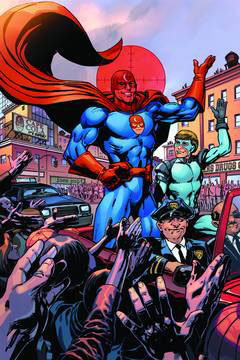 As to the genesis of the story...I think a lot of it comes from me just being a jumped-up fanboy who grew up at a time when sidekicks and junior heroes were all over the freaking place: Robin, Aqualad, Aquagirl, Speedy, Kid Flash, Wonder Girl, Rick Jones...you couldn't swing a cat without hitting a sidekick (not that I'm encouraging that kind of behavior, just saying). On a certain level, as a kid, I think I kind of resented them because I felt I could always grow up to someday be Batman or the Flash or someone else, but these sidekicks were my own age and could already do stuff I couldn't.
As to the genesis of the story...I think a lot of it comes from me just being a jumped-up fanboy who grew up at a time when sidekicks and junior heroes were all over the freaking place: Robin, Aqualad, Aquagirl, Speedy, Kid Flash, Wonder Girl, Rick Jones...you couldn't swing a cat without hitting a sidekick (not that I'm encouraging that kind of behavior, just saying). On a certain level, as a kid, I think I kind of resented them because I felt I could always grow up to someday be Batman or the Flash or someone else, but these sidekicks were my own age and could already do stuff I couldn't.
Nobody I knew took them seriously. Heck, even the villains and some of the other characters in the books themselves didn't take them seriously. So I've always wondered what would happen to a kid sidekick whose mentor gets killed...how does he get the world, the bad guys, even other heroes to take him seriously? How does he fit in? How far will he go to try and prove himself? And what happens if he finds out that maybe a large chunk of the last several years was based on a lie?
PREVIEWSworld: Previously published editorial for Sidekick has offered that this story is “presumably another deconstruction of the superhero archetype.” Would you agree with such a statement, or do you think such a comment attempts to put a triangular object inside a square box?
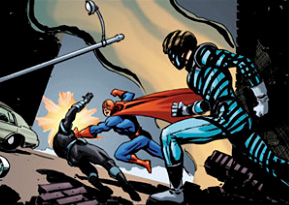 J. Michael Straczynski: It's right and not-right at the same time. ("Go not to the elves for advice, for they will tell you neither yes nor no.") The term deconstruction as it's come to be applied is so broad as to have become almost meaningless. This story isn't about deconstructing the sidekick paradigm per se, as it is about deconstructing this one character...watching his slow spiral into madness. He's not a bad guy, he started out as a really good kid and wants more than anything else to go back to being that kid, that hero...but the world keeps pounding him down and pushing him away. And there's a point where you say, "Okay, if that's what you say I am, if that's what you believe I am, then screw it, I may as well be that." It's about this one character, not deconstructing sidekicks sui generis.
J. Michael Straczynski: It's right and not-right at the same time. ("Go not to the elves for advice, for they will tell you neither yes nor no.") The term deconstruction as it's come to be applied is so broad as to have become almost meaningless. This story isn't about deconstructing the sidekick paradigm per se, as it is about deconstructing this one character...watching his slow spiral into madness. He's not a bad guy, he started out as a really good kid and wants more than anything else to go back to being that kid, that hero...but the world keeps pounding him down and pushing him away. And there's a point where you say, "Okay, if that's what you say I am, if that's what you believe I am, then screw it, I may as well be that." It's about this one character, not deconstructing sidekicks sui generis.
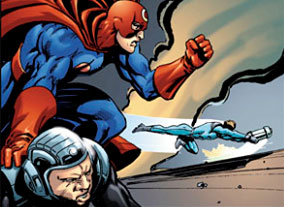 PREVIEWSworld: The solicitation text for Sidekick #1 begins by saying that The Red Cowl and Flyboy were “renowned” superheroes despite their “dopey names.” Question: why label their names “dopey?” Such “corny” titles weren’t so uncommon in the Golden Age (Green Lama, Phantom Lady, etc). So what gives with the “dopey” name line? Are you somehow setting the stage early by already “looking down your nose” at these two heroes?
PREVIEWSworld: The solicitation text for Sidekick #1 begins by saying that The Red Cowl and Flyboy were “renowned” superheroes despite their “dopey names.” Question: why label their names “dopey?” Such “corny” titles weren’t so uncommon in the Golden Age (Green Lama, Phantom Lady, etc). So what gives with the “dopey” name line? Are you somehow setting the stage early by already “looking down your nose” at these two heroes?
J. Michael Straczynski: Yeah, we're kind of stacking the deck a little, leading the witness, if you will. Thomas Winchester, our mentor character, decided to call himself the Red Cowl because, well, that's what he wears. The symbol he wears on his chest is a drawing of his own face, wearing a red cowl. He named Barry Chase, his sidekick, Flyboy because he was a boy and could fly. So it's partly a way of saying that Winchester was not the brightest bulb in the drawer...but also a way to point to the very thing you mention: that so many of the names dredged up for silver-age heroes were sometimes a tad on the dopey and uber-functional side. "Okay, we've got a kid who can eat solid matter, so let's call him...Matter-Eater Lad!" "Our character wears a red-and-white striped shirt, so let's call him... Stripesy!" (No, I'm not making that one up, google it.) So yes, we're kind of poking a bit of fun at that silver-age tradition.
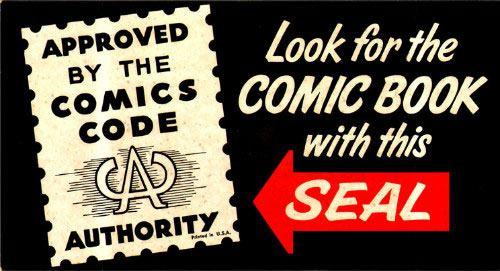 |
PREVIEWSworld: Golden Age comics, along with the Comics Code Authority, very much reflected a time in our society when we tried to keep a lid on sex, monsters, death and destruction, so that young readers wouldn’t be exposed to such themes and imagery. It seems that The Red Cowl and Flyboy are very much a product of that time. So it’s safe to say that the assassination of The Red Cowl marks the end of Flyboy’s innocence, right? Does that mean it’s natural for Flyboy to walk down a dark path now that his innocence has been shattered?
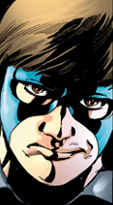 J. Michael Straczynski: I think there's a good deal of that here. If you look at the cover for issue one, the way we've staged it a pretty blatant nod to the assassination of JFK, which turned the world on its head and was the first step on a very dark road for a lot of people who lost their innocence that day. The world that Flyboy occupied before somebody snapped Red Cowl with a perfect Oswald was friendlier, simpler, more black-and-white and cornier in an endearing, wistful sort of way.
J. Michael Straczynski: I think there's a good deal of that here. If you look at the cover for issue one, the way we've staged it a pretty blatant nod to the assassination of JFK, which turned the world on its head and was the first step on a very dark road for a lot of people who lost their innocence that day. The world that Flyboy occupied before somebody snapped Red Cowl with a perfect Oswald was friendlier, simpler, more black-and-white and cornier in an endearing, wistful sort of way.
PREVIEWSworld: In the 1950s when Betty Page’s risqué photographs taken by Irving Klaw were considered too flammable for the public, we know that those pictures were nevertheless in high demand. Also, we can see in historical police photos of that same time that people still committed criminal atrocities. So we were not “innocent” back then by any means. And yet some people would argue that because bad behavior wasn’t “glorified” that the country was better for it. For instance, young people were more likely to respect their elders. Will any of this culture play out in what seems to be a time piece like Sidekick?
J. Michael Straczynski: There's no question that those who were around in the 50s viewed that distant, pre-Pearl Harbor long summer night through the lens of nostalgia, as did those who followed directly afterward. But the truth always bubbled just beneath the surface. In the 50s you had juvenile delinquent movies, a ton of prison movies and the rise of gangster and biker movies that crested in the 60s, so art has always hinted at the worlds that society tells us don't really exist. The world Flyboy has occupied since the death of the Red Cowl is not only diametrically different, at times it seems to undermine what he believed was true about those early years. It will make him begin to question just what was real about that period of his life...and he may not like all the answers he finds.
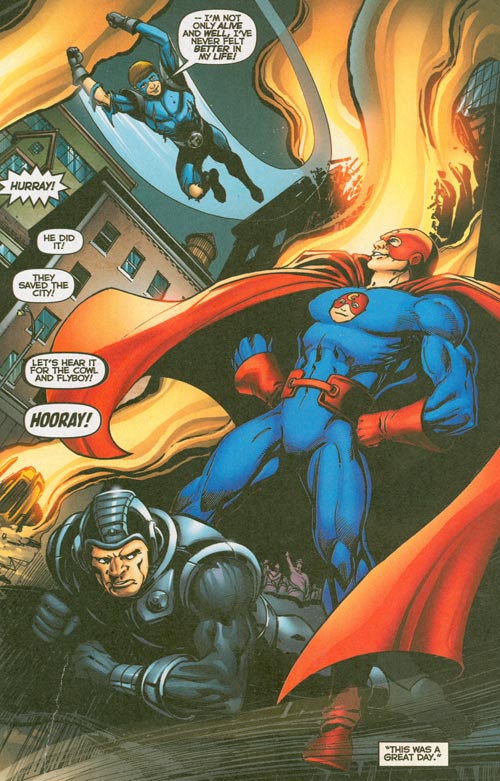 |




